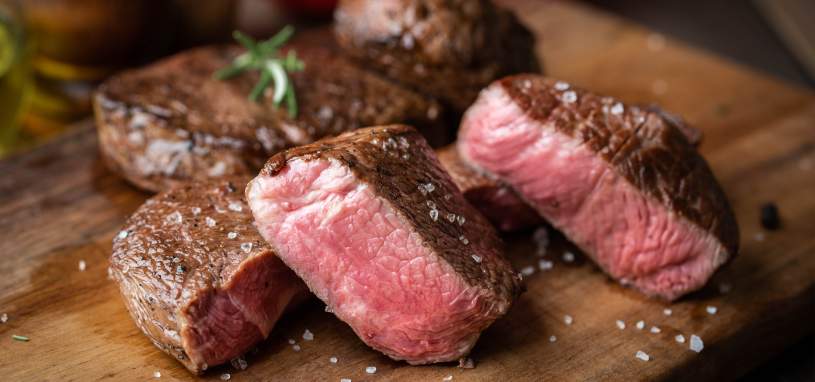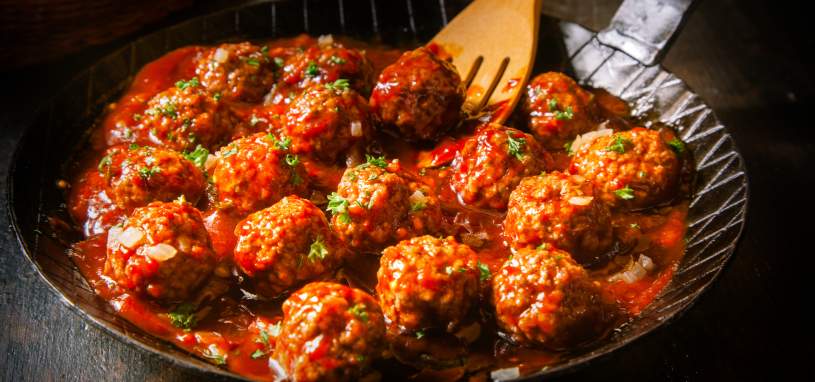Cooking beef is one of life's simple pleasures. And as if cooking beef wasn't sufficiently delightful, it can also lead to another joyful experience: eating beef. But if done incorrectly, both cooking and eating beef can be riddled with misfortune. Overcooked beef is a tragedy that rivals Hamlet.
To help you beef-up your beef cooking skills, we've put together the following guide to cooking, purchasing, and preparing exquisite beef dishes. Read on to learn about the different cuts of beef, the best way to cook them, suitable side dishes for beef, and even learn a thing or two about the best drinks to accompany your new, culinary triumphs.
Our team at Peter Bouchier refuses to sell inferior beef. Peruse our range of high quality beef products, which are available for purchase online.
What is beef?
In essence, beef is the culinary term for cattle meat—specifically, the meat that comes from the skeletal muscle of cows and bulls. It's a great source of protein and core nutrients like iron, zinc, potassium, magnesium, vitamin D, vitamin B6, and vitamin B12, just to name a few.
Humans have been eating beef in different forms since we have been able to walk bipedally. If you visit the cave paintings in Lascaux, you'll see paintings of prehistoric hunters tracking and killing great aurochs. Cattle have been domesticated several times over human history, and today, beef farming makes up around 22% of worldwide agricultural practice.
Why the millennia-long fixation on this one kind of meat? Because, when prepared correctly, beef is utterly delicious. Beef as a delicacy has a rich umami flavour (the Japanese term for amino acid L-glutamate and 5'-ribonucleotides), that nothing else can match.
What are the different cuts of beef?

Thanks to the grand size and scale of cattle, beef comes in a range of versatile cuts. The term primal cuts denotes the main sections of the cow which are then segmented for further butchering. The definition of primal cuts differ from region to region, but can be grouped (from head to tail) as chuck, brisket, shank, rib, plate, short loin, sirloin, and round.
Here are some popular cuts of beef that come from the above primal cuts.
- Beef steaks — including filet mignon, sirloin, rump, rib eye, and tomahawk — are medium sized pieces of meat cut across the muscle fibres and fried or grilled to the desired doneness.
- Beef roasts — like rib roast, chuck roast, tri-tip, brisket, and sirloin roasts — are larger pieces of meat with or without bones that are slow-cooked to tender perfection.
- Beef ribs come from the rib or plate area of the cattle, and are cooked with the bone in to produce tender, fall-apart morsels.
- Short ribs are a popular delicacy the world over. They are not the entire rib, but instead have more meat than traditional ribs, requiring greater cooking times to break down collagen and connective tissue.
- Beef mince is created by cutting older, leaner, and tougher cuts of beef into a fine, malleable ground mince for use in burger patties.
- Beef shanks come from the areas where the legs meet the body. These cheaper, fatty cuts of meat and bone are excellent for slow cooking.
- Other beef cuts can be processed into a range of food products, including jerky, pastrami, and corned beef.
Other parts of cattle can be consumed as well. Blood and intestines can be made into sausages, while the tongue, liver, kidneys, and tail of the beast can be used to make a variety of delicacies. Traditionally, the brain has also been used in cooking. However, in areas where mad cow disease is prevalent, this is forbidden.
What are the best beef cooking methods?
Beef is an incredibly versatile source of protein that can be cooked using a range of different methods. Depending on the cut and quality of the meat, and the desired result, cooking methods for beef can vary from different kinds of heat, to processing, to raw preparation.
Here are some of the most common kinds of beef cooking methods used in culinary applications all over the world.
- Dry heat beef cooking methods — where the beef is cooked on a hot surface with minimal introduced fat — include grilling, barbequing, roasting, and frying.
- Moist heat methods typically introduce tougher cuts of beef into a contained environment with liquids for a long period of time. These methods include sous vide, braising, stewing, and simmering.
- Processing beef by curing, smoking, drying, and ageing can produce a range of amazing products.
- Raw beef — a feature in dishes like steak tartare, carpaccio, and Ossenwurst — is considered an international delicacy when prepared safely.
How long should I cook beef?

The length of time it takes to cook beef depends on the cut of meat, the size of the cut, and the desired cooking result. When it comes to estimating how long your beef needs to cook, the scale and a thermometer are your best friend.
What's the desired internal temperature of beef?
Doneness is a term that relates to how well cooked your beef is. This can be measured by sight, or more accurately, using a meat thermometer.
Regardless of the size or shape of your piece of beef, you want to get its internal temperature to a bare minimum of 60°C. This temperature means that the meat is effectively cooked, killing germs and harmful bacteria that can cause food poisoning.
The following internal temperatures correspond to the doneness of your cut of beef:
- Rare — 60°C
- Medium rare — 60–65°C
- Medium — 65–70°C
- Medium well done — 70°C
- Well done — 75°C
As we stated previously, some beef can be eaten raw as part of a normal diet. If you want to eat raw beef, you should adhere to the following tips to ensure that the meat you are consuming is safe:
- Only buy the freshest possible beef from reputable sources
- Prepare and consume as soon as possible after purchase
- Store raw beef below 5°C when not in use
- Keep raw beef separate from other foods in the fridge
How long should I rest beef after cooking?
Resting beef after cooking and before eating is an essential step for every cook, both domestic and professional. Resting the beef removes the meat from the direct trauma of cooking, and allows the juices to naturally redistribute through the cut. This makes the meat more tender and infinitely juicier.
Here's how to effectively rest beef before serving for consumption:
- Remove the beef from the heat entirely
- Place the beef on a platter or plate — preferable warm, around 30°C
- Cover loosely with tin foil, or another plate
- Let the beef rest for around 1 minute per 100g
Large roasts should rest for between 10 and 20 minutes, while steaks can rest for 3 to 5 minutes. Failing to rest the beef will result in a very tough and chewy experience, not to mention, the potential for a burnt mouth.
What are some popular beef dishes?

Beef is both a delicacy and staple all over the world. Its versatility and prevalence makes it a popular choice for everything from fast food, to home comfort cooking, to high-end dining. Here are some popular beef dishes from around the world:
- Beef rendang from Indonesia is consistently voted as one of the world's most popular dishes.
- Beef short ribs have been popularised in everything from Southern American BBQ to Chinese Szechuan cuisine.
- Beef stews are an absolute staple of cooking from Britain, Ireland, Scotland, and Wales.
- Beef mince is an essential part of Central and South American dishes, including beef tacos, beef empanadas, and beef mince chilli.
- Beef meatballs are a popular highlight of cooking from both Italy, Sweden, and other places in continental Europe.
- Beef steaks cut into strips are a welcome addition to stir-fries, soups, and curries from Malaysia, Thailand, Mongolia, Thailand, and Vietnam.
Some cultural traditions prohibit the consumption of beef entirely. In many ancient and modern Indic and Asian religions, cattle were considered to be invaluable to everyday life, and were thus rendered sacred. In Jewish and Muslim traditions, beef and other cloven-hoofed animals can only be consumed if slaughtered in accordance with religious laws. Some Western religious observances, like Lent, the consumption of beef is limited as an act of personal denial.
What pairs well with beef?
Looking for the perfect pairing with beef? We have you covered. There are many drinks that pair well with beef, and few that will clash.
As a red meat, beef pairs well with red wine. Steak and red wine is a staple, but that doesn't mean other drinks won't pair beautifully with beef. A beer with a burger, for example, is an extraordinarily compatible pairing. For spirit lovers, a good whisky with caramel notes will lift up your beef accompaniment to another level.
Where can I get the best beef?
The best beef always comes from the best butchers. Not only does beef have to be prepared correctly—for a superlative meal to land on your plate, the entire supply chain has to be outstanding. It all starts with top quality farmers supplying the best produce. At Peter Bouchier, we only work with the best suppliers of beef, working locally and ethically in Victoria and New South Wales.




















